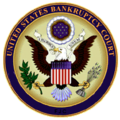| Bankruptcy in the United States |
|---|
 |
| Bankruptcy in the United States |
| Chapters |
| Aspects of bankruptcy law |
Title 11 of the United States Code, also known as the United States Bankruptcy Code, is the source of bankruptcy law in the United States Code. [1]
Contents
| This article is part of a series on the |
| United States Code |
|---|
 |